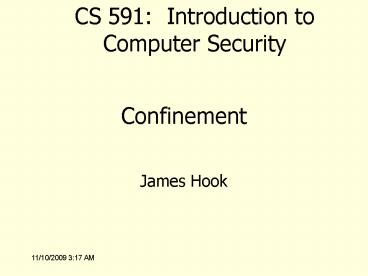Confinement - PowerPoint PPT Presentation
Title:
Confinement
Description:
... send a stream of bits to another concurrently running program. ... sender: data : = bit being sent; sendclock : = true. receiver: wait for sendclock = true; ... – PowerPoint PPT presentation
Number of Views:12
Avg rating:3.0/5.0
Title: Confinement
1
Confinement
CS 591 Introduction to Computer Security
- James Hook
2
The Confinement Problem
- Lampson, A Note on the Confinement Problem,
CACM, 1973. - This note explores the problem of confining a
program during its execution so that it canot
transmit information to any other program except
its caller. A set of examples attempts to stake
out the boundaries of the problem. Necessary
conditions for a solution are stated and
informally justified.
3
Possible Leaks
- 0. If a service has memory, it can collect data,
wait for its owner to call it, then return the
data - The service may write into a permanent file
- The service may create a temporary file
- The service may send a message to a process
controlled by its owner via ipc - More subtly, the information may be encoded in
the bill rendered for the service
4
Possible Leaks (cont)
- 5. If the system has interlocks which prevent
files from being open for writing and reading at
the same time, the service can leak data if it is
merely allowed to read files which can be written
by the owner.
5
Leak 5 (cont)
- The interlocks allow a file to simulate a shared
Boolean variable which one program can set and
the other cant - Given a procedure open (file, error) which does
goto error if the file is already open, the
following procedures will perform this
simulation - procedure settrue (file) begin loop1 open
(file, loop1) endprocedure setfalse (file)
begin close (file) endBoolean procedure value
(file) begin value true open
(file, loop2) value false
close (file) - loop2 end
6
Leak 5 (cont)
- Using these procedures and three files called
data, sendclock, and receiveclock, a service can
send a stream of bits to another concurrently
running program. Referencing the files as though
they were variables of this rather odd kind,
then, we can describe the sequence of events for
transmitting a single bit
- sender data bit being sent sendclock
truereceiver wait for sendclock
true received bit data receive clock
truesender wait for receive clock
true sendclock falsereceiver wait for
sendclock false receiveclock
falsesender wait for receiveclock false
7
Leak 6
- By varying its ratio of computing to input/output
or its paging rate, the service can transmit
information which a concurrently running process
can receive by observing the performance of the
system.
8
One solution
- Just say no!
- Total isolation A confined program shall make
no calls on any other program - Impractical
9
Confinement rule
- Transitivity If a confined program calls
another program which is not trusted, the called
program must also be confined.
10
Classification of Channels
- Storage
- Legitimate (such as the bill)
- Covert
- I.e. those not intended for information transfer
at all, such as the service programs effect on
the system load - In which category does Lampson place 5?
11
Root Problem
- Resource sharing enables covert channels
- The more our operating systems and hardware
enable efficient resource sharing the greater the
risk of covert channels
12
Resources
- Lampson, A note on the Confinement Problem, CACM
Vol 16, no. 10, October 1973. - http//doi.acm.org/10.1145/362375.362389
13
Discussion
- Bishops slides for Chapter 16 (with some minor
modifications to one example)
14
Virtualization
- Virtualization is returning to the mainstream
with Intels Virtualization Technology (aka
Vanderpool) - Discussion following Bishops slides for Chapter
29 - Secret decoder ring
- PSL Processor Status Longword (a vax status
register)
15
Applications of Virtualization
- Workload isolation
- Workload consolidation
- Workload migration
- (See Uhlig, et al, Fig 1)
16
Virtualizing Intel architectures
- As is, Intel architectures do not meet the two
requirements - Nonfaulting access to privileged state
- IA-32 has registers that describe and manipulate
the global descriptor table - These registers can only be set in ring 0
- They can be queried in any ring without
generating a fault - This violates rule 2 (all references to sensitive
data traps) - Software products to virtualize Intel hardware
had to get around this. - Vmware dynamically rewrote code!
17
Intel solutions
- VT-x, virtualization for IA-32
- VT-i, virtualization for Itanium
- Changed architecture to meet the criteria
18
Ring aliasing and ring compression
- Solution is to allow guest to run at intended
privilege level by augmenting privilege levels. - See Figure 2(d).
19
Nonfaulting access to privileged state
- Two kinds of changes
- Make access fault to the VM
- Allow nonfaulting access, but to state under the
control of the VMM
20
- Intel Virtualization Paper
- ftp//download.intel.com/technology/computing/vpte
ch/vt-ieee-computer-final.pdf































